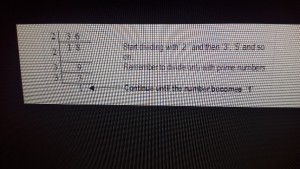Math 10 Summary
Chapter 1-Numbers- All of chapter one is based around prime factorization.My key learning from this unit was the division tables. I didn’t understand how to use them in the past because of the fact that you are only supposed to use prime factors and go from least to greatest. I always believed you could go in any order. You can but it makes it a lot easier and more organized if you go from least to greatest. Also division tables can be used to write out the prime factorization for a number.
Chapter 2- Exponents- My key learning from this unit was understanding what the different signs mean using exponents. When you are multiplying 2 numbers with the same base you add the exponents, when you are dividing 2 numbers with the same base you subtract the expontents and when you have brackets and exponents such as (x3)(x4), you multiply the exponents. Understanding these methods helped me with questions that would take a lot of time but this made them a lot simpler. Ex: (x2)4 = x8
Chapter 3- Measurement- The most important thing I learned in this unit was when converting units of measurement. You use a table and cross multiply the units. This method is very simple and easy and you always get the right answer. Also when using this method you can convert square units to other squared units by just doing the conversion twice.
Chapter 4- Trigonometry- The biggest thing I learnt in trig was the order of how you do trig questions. Here is a diagram explaining the steps and how to solve the right triangles.
Chapter 5-Polynomial operations- My key learning for polynomials was how to multiply binomials. Once I understood how to do this it helped me through the whole unit. When multiplying binomials, you distribute both of the numbers/variables in the first set of brackets to the second set of brackets. In the example below you distribute x and 3 to the other bracket and then combine like terms to get the answer
Chapter 6-Factoring polynomials- When factoring a polynomial, (ex.b² + yb + z) you need to remember that the last 2 terms in the equation have to multiply to equal the last term (z), and they must add to equal the middle term (yb).
Ex. b² + 3b + 2, the b² will be the first terms in each bracket (b + ) and (b + ). Then you list all the factors for the last term (2). ( -2 x -1, and 2 x 1). Then you find the pair that equals to 3b. -2 + -1 does not equal 3, but 2 + 1 = 3. This lets you know to use 2 and 1. Then you input the numbers where they should go (b + 2) (b + 1). To check your answer you just expand the equation to how it was before if you did it correctly.
Chapter 7- Relations and functions- My key learning for this unit was understanding how to find the x and y intercepts of equations. When you find the x and y intercept of the equation you have to understand that the x intercept will be equal to (x,0) and they y intercept (0,y). So for the x intercept y will always be 0 and for the y intercept x will equal 0.
Ex. y = 2x + 6
0=2x+6
-6=2x
x=-3
Chapter 8-Linear relations- My key learning for this unit was understanding how much the slop can tell you about a line. The biggest mistake I made throughout this unit was forgetting that when calculating slope to make sure the x and y were in the right spot.
Here is the formula for slope. When inputing the x and y values, you have to remember to keep it in this formation. I sometimes put the x value on top, or switched the equation around such as
m=y1-y2/x2-x1
It is important to keep the numbers in the right spot or else when calculating your slope you will get the wrong answer.
Chapter 9-Equations of linear relations- My key learning was understanding how to convert equations into different types such as slope y-intercept or general form. Knowing how to convert was very important because using the point slope form told you the most about a line and made it the easiest for getting answers.
This equation is also easy to convert to because all you need is a point on a line since you can figure out the slope from that. Also going to slope y intercept form is super easy because all you do is expand the equation
Chapter 10-Systems of linear equations- My key learning for this unit was understanding how to read word problems and create equations from it. When i would do word problems before all I would do is write down the variables and the numbers and try to come up with an equation. I learnt that when doing systems you need to create 2 equations so you can’t just read the entire question as a whole. Understanding that each line in a word problem can be an equation helped me out. You have to read it one sentence at a time and make equations from each sentence. Also knowing what different words mean such as total, than, etc. can help you out a lot when writing the equations.











